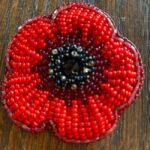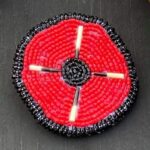Anishinabek Nation members weigh in on Poppy Protocols
In May 1915, Lieutenant-Colonel John McCrea’s poem, In Flanders Fields, introduced Canadians to the idea of the poppy as a symbol of Remembrance. Poppies grew wild in the fallow fields of France and Belgium’s Western Frontier. When the war reduced these lands to mud and rubble, the papaver rhoeas, or corn poppy, appeared only in secluded corners, particularly “between the crosses, row on row” in makeshift commonwealth cemeteries. With armistice, the flower returned and thrived in these former battlefields. The symbolism was not lost on those who wished to honour the sacrifice of war and the promise of peace.
On July 4, 1921, at the Prince Arthur Hotel in Thunder Bay, The Great War Veteran’s Association, the forerunner of today’s Canadian Legion, considered a proposal to create a Poppy Day. The following day, the poppy was officially made Canada’s Flower of Remembrance. Beginning in 1922, Canada hired the government-owned Vetcraft Industries, an employer of disabled vets in Toronto and Montreal, to produce poppies. Vetcraft continued to manufacture the poppies until it closed down in 1995. Since then, the government has contracted private firms. Inmates from minimum security prisons and healing lodges in Manitoba, Alberta and Saskatchewan are given the task of manually pinning the black poppy centre to the background flower.

During the years 1914-1918, 4,000 status First Nations people enlisted in the war. This number does not include those who joined up but did not self-identify as Indigenous. Although appearing many years later, the beaded poppy has evolved as a powerful symbol honouring these veterans and can be found throughout Canada. Several artisans and community leaders were contacted to talk briefly about their relationship with this token of remembrance.
As each poppy can take anywhere from two to five hours to make, the finished product is undeniably a labour of love. Leona Nawegahbow, a former Chief and citizen of Whitefish River First Nation, receives her poppies from a close relative who follows the Midewiwin teaching that the most powerful offerings or gifts are handmade. The time-consuming process of beading also fosters remembrance, as conversations and thoughts usually drift toward stories about loved ones who fought in the war but did not return.
Lily Armstrong, Nipissing First Nation, has a similar approach. Lily learned to bead by watching her mother but started making poppies about six years ago after a friend brought one down from a northern community. She also finds the crafting process meditative and healing. Other family members who bead with her often share these feelings.

Many of the artists interviewed commented on criticism over the idea of earning revenue from what is a solemn, commemorative symbol, and for replacing the official Canadian Legion pin with the handmade version. For some, this has slowed down their poppy-making.
In order to understand this sentiment further, we contacted the Canadian Legion and in a recent e-mail, Freeman D. Chute, National Program Officer for Poppy & Remembrance wrote, “The Poppy trademark exists to ensure the symbol’s respectful use for Remembrance and not-for-profit. Poppies can be made and given away in Remembrance but permission from Dominion Command is required before anyone can create poppies for money, and it is normally granted if 100% of the proceeds are donated to the Legion Poppy Trust Fund.”
When asked if the Legion has a policy position on the use of the beaded poppy he wrote, “The Royal Canadian Legion recognizes the Indigenous peoples of our country and have granted special permission to select Indigenous artists to create beaded poppies which we then offer through our poppy store. Proceeds from their sale go to the Legion’s Poppy Trust Fund to support our CAF and RCMP veterans and their families.” Although they may be available through other avenues, at the time of writing this article, there were no beaded poppies for sale through the Legion’s poppystore.ca.

According to the Legion’s official Poppy Manual, there are exceptions to the rules, which are considered on a case-by-case basis. Chippewas of Georgina Island First Nation Counsellor Pat Big Canoe relayed a story of a community member, the wife of a Veteran, who wished to honour her husband’s military career. She applied and received the official sanction to wear her poppy whenever she chose.
Most of the people interviewed for this story were aware of the situation and are comfortable with the choices they have made; to respect the feelings of those who may be sensitive about Legion protocols, but also to honour family and community Veterans. For Maurice Switzer, Bnesi, Citizen of the Mississaugas of Alderville First Nation, this means wearing his beaded poppy but also donating to the Legion’s annual Poppy Fund. Switzer’s philosophy echoes what many of the artisans have said: That recipients are encouraged to make a donation to the fund.
Aamjiwnaang First Nation’s Diane Aiken, who prefers to gift her handcrafted poppies, asks them to donate a little more than what they normally would, given the amount of work involved in creating a beaded poppy.

Shermen Patabon, from Long Lake no. 58 First Nation, comes from a long line of military people. He is not bothered by criticism over the beaded poppy and wears his to honour all Veterans. For each poppy that he sells, he gives a donation to the Canadian Legion. Anishinabek Nation Regional Deputy Grand Council Chief James Marsden travelled to Vimy for the Great War’s centennial commemoration in April 2017 as one of Anishinabek Nation’s delegates. He chose to wear a poppy made by Alderville First Nation’s Dianne Smoke-Thomas. Chief Marsden does not see a competition between the two types of poppies, and suggests, “You can support our artists who bead and also buy poppies to support the veteran’s programs.”
The artists interviewed say they would follow the Canadian Legion’s protocols on how to wear a poppy. According to the Canadian Legion, the poppy is worn each year during the Remembrance period (the last Friday in October through to November 11) to pay respect to Canada’s fallen. The pin should be worn on the left side, over your heart. Canadian Legion pins should not be secured by any other pin which might obstruct the poppy. Poppies can also be worn at a Veteran’s funeral, or any ceremony that honours fallen soldiers. Patabon wears his during powwows, particularly during the Veteran’s Song. Nawegahbow, who is also the Elder-in-Residence at the Ojibwe Cultural Foundation, M’Chigeeng First Nation, may wear hers at family gatherings, especially during Dgwaagig, this time of the year.

All the crafters agree that anyone can wear a beaded poppy. Armstrong sees it as a sign of respect for Indigenous Veterans, since it shows that you “are not afraid to acknowledge Native culture and raise awareness of native Veterans.”
Patabon agrees, wearing his to represent those Indigenous soldiers who have historically gone unrecognized for their participation and bravery in the Canadian military, but also, as a token of respect for all Veterans.
Readers can review the Canadian Legion’s official policies by consulting its online Poppy Manual.



